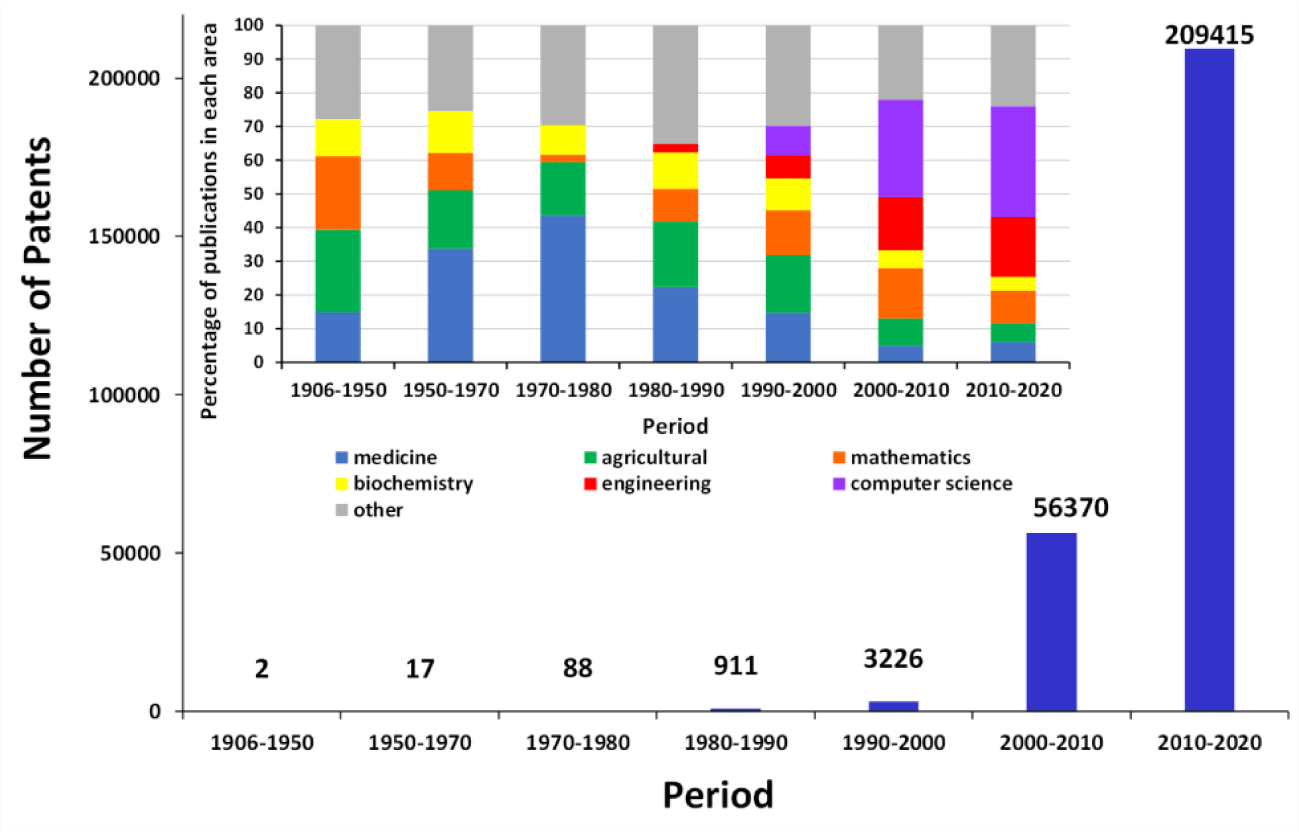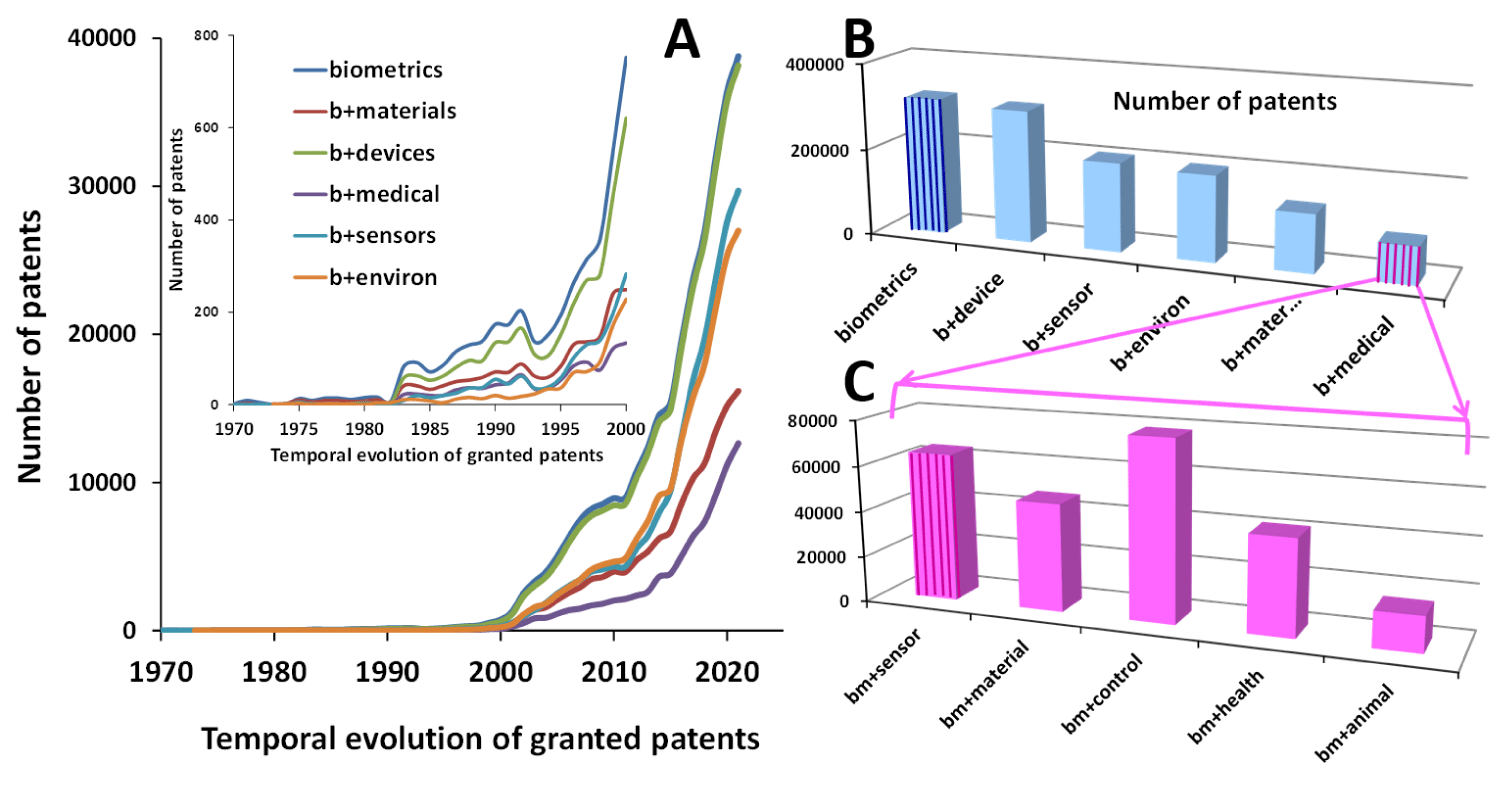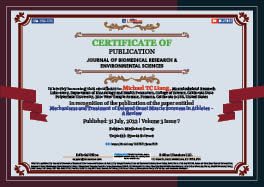General Science . 2022 July 31;3(7):842-845. doi: 10.37871/jbres1521.
Metrics of the Biometrics: The Steady Growth of an Interdisciplinary Field
Delia L Bernik*
- Biometrics
- Biometry
- Feature extraction
- Patents
- Biometric systems
Abstract
The word biometry or its derivative, biometrics, depicts the need for close interdisciplinary research among big data systems, mathematics, and statistical sciences. Reports headed with the word biometrics are constantly increasing. Below, the information provided by databases evidences the expansion and evolution from the original main biological topics to new research areas.
Results and Discussion
This work shows a picture of the development and evolution of production related to biometrics, with particular attention to the interrelation of research articles and patents.
The temporal evolution of production was retrieved through a database that allows comparison between publications in different thematic areas with their associated patents.
Publications
When searching for publications where the word biometrics is in the title, the results are those depicted in figure 1, showing the main retrieved subject areas: computer science (comp); engineering (eng); mathematics (mathe); medicine (medic); agricultural and biological science (agri-biol), social science (social), physics and astronomy (phys-astro); biochemistry, genetics and molecular biology (biochem); materials science (mater).
The results show that at the beginning of the last century the leading role was played by the set of biodata (medical, agricultural-biological, and biochemical). This was well described in an article from the early 20th century: undefined authors mention “vast collections of data accumulated by anthropologists who had neither the method nor the tools to put them together into a composite whole” (referring to measurements of brain weights obtained by pathologists) which urgently required an application of the "mathematical science of statistics" [1].
This was progressively changing, and in the last two decades, the subject areas of computing and engineering take center stage (Figure 1B). Also, the areas of biometric systems and devices associated with the research on nanostructured materials are growing. Examples of this are the design of new polymeric electrodes for high-quality biometric information sensing [2,3].
The word biometrics was almost sequestered as a descriptive word for the use of biometry in security matters. Of the 15,000 retrieved references, 9,000 are selected by asking for the word "security" as an additional restriction [4,5].
Note that there is considerable dispersion in the information provided by the different databases (net number of documents/patents retrieved). Therefore, to facilitate the retrieval/reproduction of the information reported here, the data was obtained using only Scopus.
Publications and patents
It is interesting to look at the interdependent evolution of publications and patents. Figure 2 shows the evolution of the subject areas to which biometric studies and publications are dedicated (inset), and the evolution of the number of patents registered related to them (main frame).
The evolution of the subject areas of the publications reflects the history of biometrics. The great takeoff of patents coincides with similar growth in research and publications in engineering and computing. To give a piece of complete information, other areas of research included in "other" are environmental sciences, immunology, decision sciences, social sciences, physics-astronomy, all of which vary their weight percentage depending on the time window chosen.
Patents
Of the 15,023 documents retrieved asking for the word “biometrics” to be in their title, 315,280 associated patents are reported worldwide. Of the offices examined by Scope, the one that registers the vast majority of these patents is the United States Patent & Trademark Office (USPTO), followed by the Japan Patent Office (JPO), the World Intellectual Property Organization (WIPO), and the European Patent Office (EPO).
Of those 315,280 patents, less than 0.3% were registered between 1925 and 1990. Although the term biometrics appears already at the beginning of the 20th century in scientific publications [6,7], the first patents show up practically at the end of the last century. Figure 3 (part A) shows that the big jump has been in the last 10 years, with almost 80% of all patents registered.
The curves in part A show how the additional filter introduced by the word “devices” is the only one that does not significantly decrease the number of patents retrieved from the search. However, this is the case only from the year 2000, approximately, since the inset shows that between 1990 and 2000 there is a noticeable decrease in the number of patents retrieved.
In part B, the bar plot shows the total recovered patents with the same restrictions as in part A: (TITLE (biometrics)) AND (X), that is, the word biometrics should be in the title and an additional filter with the word “X”, X being device; sensors; environment; materials; medical. Part C incorporates a second level of restriction, C: (TITLE (biometrics)) AND ((medical)) AND (xxx), being x different words (sensors, materials, control, health, animal). This allows seeing how many patents with the word biometrics in their titles, devoted to medical fields, have developments in the areas described by these words.
The restrictive words shown in part B are between those recovered as the main fields/areas when retrieving the publication documents with the word “biometrics” in the title, intentionally selecting those areas different than those involved in identification/ security issues.
Patents represent the purpose to protect and the intention to give commercial value to acquired knowledge. A possible interpretation of the gap between the beginning of the development of biometrics publications and the appearance of patents could be made considering the temporal evolution of the artificial intelligence methods, shown in figure 4.
The progress of mathematical and statistical methods took a few more decades, together with the evolution of technology (informatics) and electronics (computers). The confluence of the development of these three areas allowed improving the use of the mathematic-analytical tools, giving rise to marketable "devices" in the 80s-90s.
As mentioned before, the word biometrics was almost hijacked for its use in security and authentication matters. This is evidenced by verifying that, of the total number of registered patents, more than 96% arise from the search for patents with “biometrics” and the additional restriction (filter) “device” and “security”. However, biometric devices are not only dedicated to security issues, as could be erroneously inferred from previous reports focused on that topic [8,9]. To give other examples, advances in biometrics authentication are applied to improve human health care, where biometric information is used in cardiac health monitoring, the building of personal medical databases, and health control by using mobile phones [10-12]. An example of a personalized application of biometrics in personal care is the patent describing a system and method for the prediction of smoking behavior and assisting in smoking cessation, which can be achieved by monitoring biometric variables [13]. In another field, a recent patent shows the use of biometrics to extract information from plants in a crop field, which facilitates the automation of crop control and treatment [14]. And lately, as with the publications, the research and development of materials that improve the detection systems of biometric devices are also increasing. As an example, the new thin-film transistor photodetectors embedded in “transparent materials” give rise to the patent registered by Kim [15], among many others.
Perspectives
There are some differences between patent bibliometrics and classic bibliometrics. Mainly, indicators such as content, access, and indexing, but also timeliness and citation [16,17]. Bibliometric analysis of patents can also focus on elements such as keywords and claims (a patent can consist of a process, product, or both [18]). Therefore, this work can be helpful for researchers and professionals by providing a broader perspective of analysis focusing on the information provided by the comparative study of papers and patents, not limited to the academic field of publications but also open to developments in industrial research.
Conclusion
From its origin as mathematical methods of scientific analysis of biological data, the scope was changing, first turning to security and identification issues and, at present, broadening to a new spectrum of technological fields, thus recovering part of its initial course of action. This report seeks to stimulate subsequent research and bibliometric analysis of Biometrics patents.
Acknowledgment
D.L. Bernik is a member of the Researcher Career, National Research Council, CONICET. This work has been partially supported by a grant from the University of La Plata, Argentina, project code X-834.
References
- No author name available. The Biometrics of Brain-Weights. Nature. 1905;73:200-203. doi: 10.1038/073200a0
- Park J, Youn JR, Song YS. Carbon Nanotube Embedded Nanostructure for Biometrics. ACS Appl Mater Interfaces. 2017 Dec 27;9(51):44724-44731. doi: 10.1021/acsami.7b15567. Epub 2017 Dec 12. PMID: 29190074.
- Silva AS, Correia MV, de Melo F, da Silva HP. Identity Recognition in Sanitary Facilities Using Invisible Electrocardiography. Sensors (Basel). 2022 May 31;22(11):4201. doi: 10.3390/s22114201. PMID: 35684820; PMCID: PMC9185406.
- Annavarapu A, Borra S, Thanki R. Progression in Biometric Recognition Systems and its Security. Advances in Intelligent Systems and Computing. 2022;1167:535-542.
- Habibu T, Luhanga ET, Sam AE. A study of users’ compliance and satisfied utilization of biometric application system. Information Security Journal: A Global Perspective. 2021;30:125-138.
- Greenwood M, White JDC. A biometric study of phagocytosis with special reference to the "opsonic index.": First memoir on the frequency distributions of phagocytic counts. Biometrika.1909;6:376-401.
- Pearson K. A biometric study of the red blood corpuscles of the Common Tadpole (rana temporaria), from the measurements of Ernest Warren, D.Sc. Biometrika. 1909;6:402-419.
- Lalović KG. Patent overview: Device for fingerprint identity guarantee. Vojnotehni Čki Glasnik/Military Technical Courier. 2018;66:366-379.
- Lee JW, Lee WK, Sohn SY. Patenting trends in biometric technology of the Big Five patent offices. World Patent Information. 2021;65:102040-102049.
- Volosin KJ, Weinstein U, Fletcher AMM, Pemural R. Contextual biometric information for use in cardiac health monitoring. Pat WO20221130152(A1). 2022.
- Reiner B. Apparatus and methods for utilizing biometrics in medical applications. US Patent. 2009.
- Tanaka M, Matsui T. Biometric system, biologic information storage, and portable device. US Patent 10,803,156. 2020.
- Utley DS, Jameson A, Marler J. Systems and methods for quantification of, and prediction of smoking behavior. US Patent 11,278,203. 2022.
- Papanikolopoulos N, Morellas V, Zermas D, Mulla D, Bazakos M. Crop models and biometrics. US Patent 11,275,941. 2022.
- Kim H. Display panels for processing biometrics using TFT photodetectors integrated thereon. US Patent 11,152,409. 2021
- Narin F. Patent bibliometrics. Scientometrics. 1994;30:147-155.
- Jürgens B, Herrero-Solana V. Patent bibliometrics and its use for technology watch. Journal of Intelligence Studies in Business. 2017;7:17-26.
- da Silva Florêncio MN, de Souza Abud AK, Gomes Costa BM, Martins Oliveira Junior A. The sectoral dynamics of the protection of biotechnology in Brazil. World Patent Information. 2020;62:101984-101994.
- Castillo D, Lakshminarayanan VMJ, Rodrígez-Álvarez MJ. MRI Images, Brain Lesions and Deep Learning. ScreeningAppl Sci. 2021;11:1-41.
Content Alerts
SignUp to our
Content alerts.
 This work is licensed under a Creative Commons Attribution 4.0 International License.
This work is licensed under a Creative Commons Attribution 4.0 International License.












